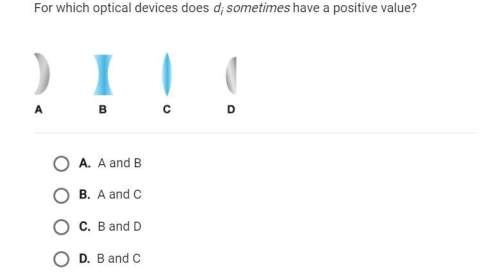
Physics, 26.01.2021 17:50 annakoslovsky3040
An object of mass m is placed on Spring A, which is compressed by distance x. The spring is released and the velocity of the pushed object as it leaves the spring is measured. The experiment is repeated with the same object on Spring B, which is compressed by the same distance x. The object travels faster when pushed by Spring B. What can be concluded?
A .Spring A had a higher elastic potential energy than Spring B.
B. Spring A's spring constant is higher than Spring B's.
C. Spring A's spring constant is lower than Spring B's.
D. Spring A has more mass than Spring B.

Answers: 1


Another question on Physics


Physics, 22.06.2019 15:00
A10 kg box initially at rest is pulled 18 meters across a horizontal, frictionless surface by a 40 n force. what is the block’s final velocity over the 18 meters?
Answers: 2

Physics, 22.06.2019 15:00
10 points! will mark brainiest! in a heat engine if 1,000 j of heat enters the system and the piston does 500 j of work, what is the final internal energy of the system if the initial energy was 2,000 j 1: write the equation2: list out your known variables 3: plug the numbers into the equations 4: solve 5: write your solution statement that includes initial energy and final energy added you so much!
Answers: 2

Physics, 22.06.2019 17:00
In the future, people will only enjoy one sport: electrodisc. in this sport, you gain points when you cause metallic discs hovering on a field to exchange charge. you are an electrodisc player playing the popular four disc variant. the disks have charges of qa = −8.0 µc, qb = −2.0 µc, qc = +5.0 µc, and qd = +12.0 µc. (1) you bring two disks together and then separate them. you measure the resulting charge of these two disks and find that it is +5.0 µc per disk. which two disks did you bring together? (a) a and b (b) a and c (c)a and d (d)b and c(e) b and d (f) c and d. (2) you bring three disks together and then separate them. you measure the resulting charge of these three disks and find that it is +3.0 µc per disk. which three disks did you bring together? a, b, and c (a) a, b, and d (c) a, c, and d (d) b, c, and d. (3) given the resulting charge of each disk measured in (b) is +3.0 µc, how many electrons would you need to add to a disk of this charge to electrically neutralize it? electrons
Answers: 3
You know the right answer?
An object of mass m is placed on Spring A, which is compressed by distance x. The spring is released...
Questions

English, 28.09.2020 19:01


Social Studies, 28.09.2020 19:01

English, 28.09.2020 19:01

Mathematics, 28.09.2020 19:01

Computers and Technology, 28.09.2020 19:01


Mathematics, 28.09.2020 19:01


English, 28.09.2020 19:01


Computers and Technology, 28.09.2020 19:01

English, 28.09.2020 19:01


Mathematics, 28.09.2020 19:01

History, 28.09.2020 19:01

English, 28.09.2020 19:01

Mathematics, 28.09.2020 19:01

Computers and Technology, 28.09.2020 19:01

Mathematics, 28.09.2020 19:01




